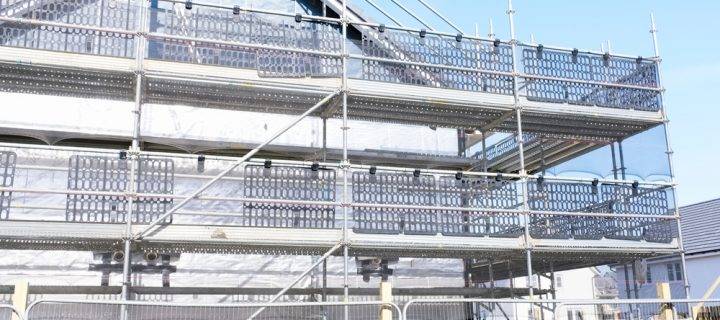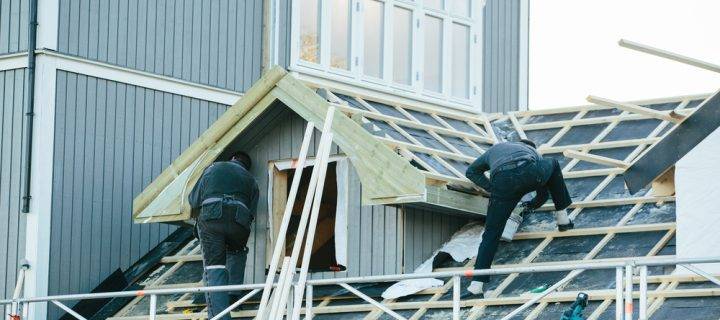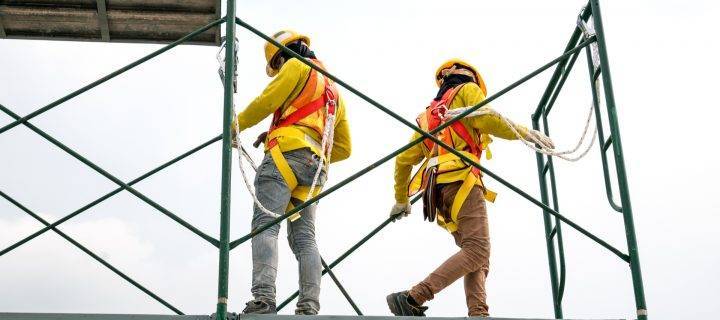Across the scaffolding industry, the number of accidents and injuries fell to an all-time low in 2019. This is according to the NASC, with just 74 incidents reported throughout the calendar year. Explaining the NASC Safety Report These figures were released in the NASC 2020 Safety Report, a document which analyses accident and injury stats for all members, which encompasses 17,000 scaffolding operatives in the UK. Another fantastic statistic revealed that 99% of NASC member-employed operatives went through the whole of 2019 injury-free. For the seventh year in a row, there was also no operative fatalities. The 74 incidents equate to one injury for every 230 operatives, a significant improvement on last year’s one injury for every 150 operatives. From the total incidents, 13 were recorded as major (meaning they required hospital treatment) with the rest recorded as over 7-days. Both of these figures were also the lowest on record. Slips, trips and falls accounted for the majority of reported incidents – 28 in total. This is now the 15th year in a row that slips, trips and falls have been the main cause of injury to operatives. This accounts for 21% of injuries in 2019. Lynn Way, NASC President commented, “The 2020 Safety Report demonstrates in no uncertain terms that NASC members are incredibly safe, and justifies the decision taken by an increasing number of main contractors to specify NASC-only for their scaffolding requirements.” The Safest Scaffolding in Derby Our first priority here at Network Scaffold is the safety of both our staff, on-site workers and members of the public – dependant on the type of job. This is why our Health and Safety Policy is so robust, encompassing – Compliance with the latest laws and regulations Effective communication relating to safety on-site Collaboration with customers and suppliers to ensure jobs are delivered safely Constant re-assessment of our procedures to adapt to new site practices We also support any worker who refuses to work on a site due to poor health and safety Network Scaffold is the leading provider of scaffolding in Derby; if you would like to know more about our services please contact us...
Read Moreabout Safe Scaffolding Means Less AccidentsScaffolding inspections are an integral part of ensuring the work being conducted is safe and adheres to industry standards. Here at Network Scaffold, we understand the importance of ensuring the safety of our team, other workers and the general public (depending on the location of the site). For our latest blog, we are going to talk about workers who can undertake scaffold inspections. The Importance of Qualified Scaffolding Inspectors Legislation states that anyone carrying out inspections must be competent, meaning the person must have the necessary training, knowledge and experience. As a minimum, they should have one of the following qualifications – 1. A Construction Industry Scaffolders Record Scheme (CISRS) cardholder, provided their employer demonstrates necessary knowledge and experience. 2. A CISRS Advanced Scaffolder cardholder, again provided their employer demonstrates sufficient knowledge and experience. 3. A CISRS Scaffolding Supervisor cardholder, plus if the person also holds the Advanced Scaffolders card they are deemed competent to inspect advanced structures. 4. A person who has taken the Basic Scaffold Inspection Course, and can demonstrate the necessary knowledge and experience from the course. 5. A person who has taken the Advanced Scaffold Inspection Course, and again shows sufficient knowledge and experience gained from the course. 6. Persons required to carry out inspections of System Scaffolds must have their card endorsed with the product selected plus attending the basic scaffold inspection course and attend an approved product training course for the specific system scaffold required. Speak to the Scaffold Specialists Today If you require scaffolding for your next project, look no further than Network Scaffold; the leading provider in Derby and the surrounding areas. Network Scaffold can also provide alloy towers, edge protection and access scaffolding for both domestic and commercial projects. If you have any more questions about scaffolding, please contact us or visit our FAQ page to see if answers are already provided on this...
Read Moreabout Who is Competent for Scaffold Inspections?In the wake of the COVOD-19 pandemic, new guidelines have been released from the Scaffolding Association regarding risk assessments and site inspections. As an associated member of the Scaffolding Association, Network Scaffold are adhering to new measures put in place to maintain social distancing and keep our workforce and the general public safe. The Importance of Risk Assessments A risk assessment is a key element to determining the frequency of periodic inspections and identifying scaffolds that may be at most risk from adverse weather. Here are some points that should be considered for risk assessments on low risk and high-risk sites – Low-Risk Sites This type of site is usually self-contained with a low risk of the scaffold structure being compromised or components falling outside of the site boundary. Examples include – Site using scaffold that is less than 10 metres in height Sites with fencing or hoarding where the scaffold is not adjacent to the boundary A commercial site where the business operations have ceased High-Risk Sites This type of site will be situated in the public domain, or are self-contained with the scaffold structure at high risk of being compromised or components falling outside of the site boundary. Here are four examples to note – Sites with scaffold over 10 metres in height A site using sheeted scaffolds or temporary roofs Sites adjacent to highways, transport areas or utilities A commercial site where the business operations continue to function How to Undertake Scaffolding Inspections The Government is currently advising that people, except for essential workers, to stay at home because of the direct risk to life from COVOD-19. Where undertaking an inspection is necessary, guidelines should be considered and implemented. Before attending site for inspections, you will need to have the following in place – The correct contact details of the Client or Principal Contractor Arrangements for gaining safe access to the site Suitable lone working procedures for the Scaffold Inspector COVOD-19 risk assessment for the Scaffold Inspector COVOD-19 risk assessment for any individuals required to carry out necessary remedial works Want to Know More? Contact Us Today If you have any more questions about scaffolding services provided by Network Scaffold, please get in touch...
Read Moreabout Guidance for Scaffold Inspections and Risk AssessmentsReplacing tiles, repairing cracks and structural jobs are all complex tasks for carrying out roof repairs. Network Scaffold would always recommend you work with a qualified roofing professional, as they all have several risks for both access and safety that you need to be aware of. The important question is – do you need scaffold or a ladder for roof repairs? Scaffolding will cost you more, but can put a price on safety? What you get with scaffolding from Network Scaffold, is high-quality scaffold from accredited professionals who are members of the Scaffolding Association. Below we are going to provide the necessary guidelines for your next project to help to make an informed decision. What Size is the Project and How Can Scaffolding Help? For smaller projects, such as a minor gutter repair or fallen roof tile towards the edge of the roof that only needs one of two people – you will be okay using a ladder. However, for larger repairs such as laying new roof tiles across your whole roof requires a proper risk assessment report – meaning you need scaffolding. Jobs that require work on your entire roof are also going to need scaffold, as it gives those carrying out repairs a safe and sturdy platform to stand on and carry out the work more efficiently than going up and down a ladder every few seconds. For workers on the ground, scaffolding is also safer, as if the scaffold is fitted with edge protection it will alleviate the risk of materials falling and causing injuries. Chutes can also be installed to allow the safe transportation of materials. How Long Could Your Project Take? If your project takes longer than a day, using scaffold is always the best option, as it is more efficient plus the fact the elements can take their toll over a number of days. Scaffolding is much more robust in harsher conditions compared to a ladder. With the recent Storm David, Storm Ciara and Storm Jorge reinforcing this point. Want to Know More about Scaffolding? Contact Us Today If you want to know more about scaffolding for commercial and domestic projects, please get in touch with Network Scaffold...
Read Moreabout Roofing Repairs using ScaffoldingHere at Network Scaffold, we understand the importance of providing the safest scaffolding for both commercial and domestic projects. For our latest blog, we are going to explain the legal requirements, competence and supervision guidelines for scaffolding. All scaffolds must be erected, altered and dismantled in a safe manner, which is achieved by referring to guidelines provided by the National Access & Scaffolding Confederation (NASC) in a document called SG4: Preventing Falls in Scaffolding. Contractors need to follow similar guidance provided by the manufacturers of their scaffolding system (such as Network Scaffold) or by consulting Access Design & Safety literature on Design Safe. Contractors need to be aware that any proposed alterations or modifications which takes scaffold outside of a generally recognised TG20 configuration must be designed, checked and proven via calculations by a competent person. What Should Scaffold Design Include? Work at Height Regulations 2005 state that unless scaffolding is assembled to a recognised configuration and must be designed by a competent person with bespoke calculation. This ensures the scaffold will have required rigidity, strength and stability during the erection, use and dismantling. Competence and Supervision Guidelines for Scaffold Employees must be competent for scaffolding work they undertake and receive sufficient training which is relevant to the complexity of the scaffolding they are working with. At the minimum, each member of your scaffolding team needs to contain a competent person who has the appropriate level of training needed for the scaffold they are working with, that covers how to erect, alter and dismantle the scaffold. Trainee and apprentice scaffolders should always be directly supervised by a competent person. Any operative who has yet to complete approved training methods and assessment should be considered trainees. Want to Know More? Get in Touch If you have any more questions about our services, please contact us today. Network Scaffold is the leading suppliers of scaffold and access scaffold across the East Midlands – including Derby and...
Read Moreabout Understanding the Legal Requirements of Scaffolding




